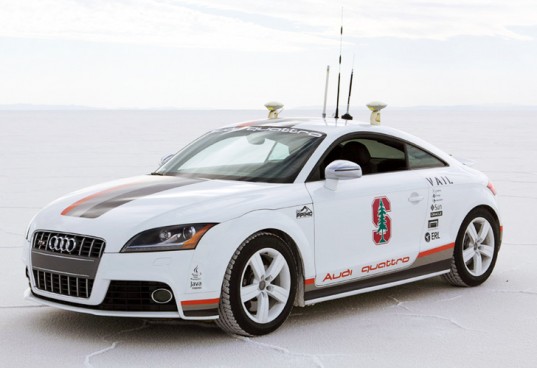
Sorry Doc Brown, but where we’re going we’re still gonna need roads – just maybe not drivers. After Lexus highlighted its autonomous vehicle strategy yesterday, Audi announced today at its CES 2013 press conference its own plans for the future of driverless vehicles.
Ricky Hudi, Audi’s Head of Electronics Development, was eager to announce the company’s pack-leading position as the first automaker granted license in the state of Nevada to test self-driving cars. Nevada passed a law last year making it legal to test autonomous vehicles in the state. And since then, other companies, including Google and Continental, have acquired their licenses as well.
Of course, Audi isn’t green to the self-driving scene. Audi’s parent company, Volkswagen, collaborated with Stanford University not long ago to develope an autonomous TTS for the Pike’s Peak Hill Climb outside Denver, Colorado.
Nevertheless, building cars that can drive themselves is no small endeavor. From Lexus to Google, the current crop of self-driving cars feature trunks full of gear and roof racks loaded with laser sensors. That bulky reality simply won’t compute for consumers, though, and companies like Audi, Google, and Lexus will need to find ways to shrink down the hulking masses attached to their cars of the future.

Audi seems to be further along than others in this endeavor; during the press conference, Hudi demonstrated its ongoing research by holding up prototype versions of small laser sensor array and a slightly larger than a normal motherboard that houses all the controls for a self-driven vehicle’s onboard electronics.
The mission to bring self-driving cars to the masses isn’t just a race; instead it’s a war of words – or definitions, in this case. Lexus’s advanced active safety research vehicle, itself on display at CES, places drivers firmly in the equation, acting more as a co-pilot auxiliary to the driver. Google is taking a more hands-off approach (no pun intended) with driving responsibility, as it’s the company’s onboard systems that are ultimately responsibility for driving. Audi, on the other hand, seems to be taking the middle road, defining its self-driving technology as “piloted driving”, one in which drivers will still be able to control the vehicle when desired, but also need to be active and engaged while being driven.
Editors' Recommendations
- Volkswagen is launching its own self-driving car testing program in the U.S.
- How a big blue van from 1986 paved the way for self-driving cars
- Watch San Franciscans take a ride in Waymo’s self-driving car
- The future of transportation: Self-driving cars? Try self-driving everything
- Apple Car will be fully autonomous with no driver input, insiders claim


